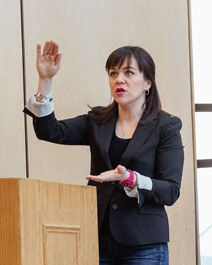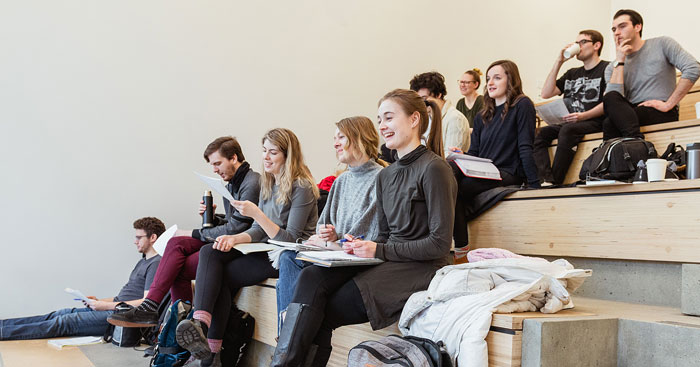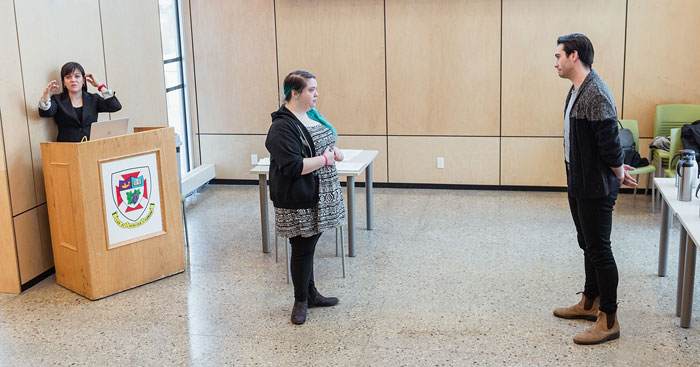Lexical sets and more
Tue. Mar. 5, 2019
Workshop feature (Part 2 of 3)

Professor Shannon Vickers leads an audition prep workshop.
Photo credit: Bohdan Dyck
Prof. Vickers has selected the play for today’s workshop Miss Bennet: Christmas at Pemberley, by Lauren Gunderson and Margot Melcon, from RMTC’s 2019-20 season. Because the play was written as a sequel to Jane Austen’s Pride and Prejudice, the dialect that will be used will be what is known as Received Pronunciation (or Standard British). Vickers describes the dialect as “not too marked by variations in sociocultural status or region”. Using her skills as a dialect coach, Prof. Vickers will be helping Theatre and Film students and alumni as they prepare to audition for the RMTC’s 2019-20 season.
The first recommendation she gives to would-be thespians is to listen to samples of the appropriate dialect. With RP, this is easy, she says, as there’s so much available in movies, such as Harry Potter or Sherlock Holmes pieces, and on TV. And—it should be no surprise, I guess—that there’s even a website (dialectsarchive.com) that makes literally hundreds of clips easily available. Vickers suggests that an actor put together play lists of samples to immerse oneself in the dialect, which can easily be done on Youtube and saved for future reference.

THFM students and alumni work with the ‘sides’ from the play “Miss Bennet: Christmas at Pemberley” by Lauren Gunderson and Margot Melcon.
Photo credit: Bohdan Dyck
Of course, it’s one thing to hear the sound and another to actually make it. But using theory, Prof. Vickers explains, one can break down speech in ways that can help an actor get there. She distributes a hand-out featuring “RP Accent Features”.
- Oral posture – By simply, changing the shape of the mouth, one changes the acoustic output. For example, Vickers describes RP the oral posture as “tense”, but “not as in stressed out or not fun at parties”, she adds with a smile. In RP, the upper and lower jaws are close together, the back of the roof of the mouth is raised, and the lips are tensed and spread like an “envelope slot”, and, in her best RP, she jokes, “I’m getting very good at this. I’m going to take all the work away from Emma Watson!” She contrasts this with a Texas drawl in which the oral posture is more relaxed or “lax”.
- General features – If one stands back to listen to a person speaking what one might notice is the musicality of the accent; the pitch, the volume, and the word stress which are general features of speech. Here, Vickers notes that in RP “speech tends to be fast and fluid.”
- Lexical sets – Next, the discussion of technique starts getting more technical as Prof. Vickers explains the use of lexical sets as a way into dialects. These are groupings of words that have similar sounds, which indicate what is occurring with the vowel sounds within them. For example, if we can hear how someone says the lexical set word GOAT, we will have a sense of how they may also say words like no, home, show, boat. (Lexical Set header words are always capitalized). Consider the following.
- the vowel sound in the word BATH (our first lexical set word to explore):
In our Canadian dialects, the vowel in BATH would be the same as the one we may employ when we say the word TRAP; where these two sounds have merged as one. In RP, the vowel employed would be farther back in the mouth (similar to what we hear when we say the word ‘spa’). - the vowel sound in the word THOUGHT (our second lexical set word to explore):
In RP, words that belong within this grouping include all, law and saw. An accessible way to hook into this vowel sound is to consider that the words ‘soar’ and ‘saw’ are homonyms in Received Pronunciation. One might say “I saw the bird soar through the sky” where the pronunciation of “saw” and “soar” are identical. This exploration often helps actors to begin to work with this vowel sound and then to apply it to other words within this lexical set grouping.

Prof. Vickers gives students feedback as they work through the sides of the play.
Photo credit: Bohdan Dyck
Prof. Vickers suggests that focusing on a few key sound shifts, while also working with the oral posture of the dialect, can go a long way to supporting great dialect work. She says that oftentimes in a rehearsal process, she is helping actors to identify and work with the shifts required in the back vowels (LOT, THOUGHT, CLOTH) which sound similar to each other in Canadian speech, but require a different shape when employing the RP dialect. Vickers moves on to review the rest of the overview she has created for the RP dialect, and speaks to the actors assembled about how the accent is non-rhotic in nature (the ‘r’ sound after most vowels is not employed). Canadian speech tends to be rhotic, whereas RP is a non-rhotic accent.
Before breaking for lunch and practice, Prof. Vickers reminds us that the goal is to have the dialect integrated to serve the primary master, which is the text itself. Ideally, the accent is so natural that the listener’s focus is on the what’s being said, rather than how it’s being said and that we’re not “taken out of the story” by it. The story is the most important aspect of what we are engaging in.
After lunch, Prof. Vickers works with us using the audition sides, giving encouragement and feedback to individual actors and coaching them towards greater fluency and skill development with the material.
It’s been a full day to be sure. It’s time well spent, Prof. Vickers says, if the students “shine” in their debut auditions at Canada’s largest regional theatre, which, in turn, raises the profile of the Department. And, it’s efforts like these, I’m sure, that make UWinnipeg’s Department of Theatre and Film’s program so highly regarded and its graduates so successful.
See also:
THFM prof hosts audition prep (Workshop feature, Part 1 of 3)
More from the audition prep workshop (Workshop feature, Part 2 of 3)
